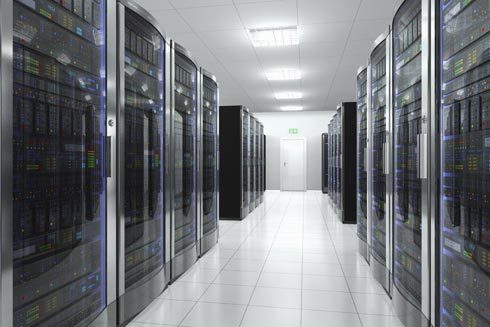Data Center Environmental Monitoring
NTI's Environment Monitoring Solutions for Data Centers, Server Rooms, & IT Network Closets

As Internet commerce climbs in popularity, server uptime is essential to businesses. Uptime is a measurement of how long servers remain operational for users without crashing or requiring a reboot. The interactions between servers and their environment often pose a major risk to server availability, with potential threats such as temperature, humidity, water leaks, intrusion, vibration, human error, and power outages. Costs of environmental threats to data centers include: replacement of damaged items, lower worker productivity due to downtime, lost revenue from unavailable server-based applications, and additional administrative time and money spent on investigating and fixing problems. A crucial part of sustaining high availability lies in identifying and monitoring environmental threats in server rooms, which enable prompt response to detected dangers before they escalate.
Potential Problems in a Data Center:
- Overheating equipment
- Unauthorized rack access
- Air conditioning failure
- Accidentally leaving rack door open
- Gradually rising temperature in room
- Leaks from air conditioner
- UPS failure
- HVAC vent obstruction
- Electrical fire
- Gaps in monitoring and responsibility
Stay up to date on environmental situations in network closets, server rooms, and enterprise level data centers with fully scalable ENVIROMUX® Environment Monitoring Systems. Receive alert notifications via web interface, email, SMS messages, SNMP, voice phone calls, alarm beacon, and sirens to ensure threats are quickly resolved. The environmental rack monitors can also activate outlets and alarms using output relay switches, such as turning on additional air conditioning when temperature rises. Schedule alerts according to each personnel's shift to minimize emergency response times. A single point monitoring software supports up to 3,000 monitoring systems, allowing smooth upscaling for any enterprise level.
| Applications | Products |
|---|---|
| Basic Applications | E-MICRO, E-MINI-LXO, E-1W |
| Intermediate Applications | E-2D, E-5D |
| Large Enterprise Applications | E-16D |
Temperature
Place temperature sensors in server racks and air conditioning system vents to monitor rack temperatures and hot and cold aisles. Excessive heat degrades network performance, causes downtime, and can result in damaged equipment. Prevent servers from overheating, meltdowns, and costly replacements.
Humidity
High humidity causes condensation and fungal growth, which can result in electrical shorts in circuits or circuit breakers and damage equipment. Low humidity increases the chances of electrostatic discharge (ESD) and the breakdown of certain plastics.
Water
Rope-style, spot, tape-style, and under carpet leak detectors monitor for damaging water leaks and other conductive fluids that might threaten the data center. Server rooms with raised floors are particularly vulnerable to undetected water damage as all cables and wires are concealed beneath floor panels. Water sensors should be placed on the floor, underneath pipe junctions and ventilation systems, and in air conditioning drip pans.
Airflow
Monitor continuous air flow in an HVAC duct, under a raised floor, or near a cooling fan on a rack cabinet or server. Insufficient air flow can be caused by many factors such as a malfunctioning cooling fan, increased friction, or physical blockage.
Smoke & Gas
Monitoring for developing smoke is essential in the security and safety of any facility. Smoke detectors help detect the initial signs of component fires in server cabinets.
Use Hydrogen Sulfide detectors to sense the presence of Hydrogen Sulfide from failed UPS lead acid batteries. Sensors are also available to detect carbon monoxide, carbon dioxide, combustible gas (methane, propane, butane, acetylene, etc.), and hydrogen gas.
Access Control & Intrusion
Keypads, electric door strikes, and door contact sensors restrict and monitor access of key entry places such as doors into a data center and doors to network closets and UPS cabinets. Outdoor and indoor motion sensors detect and/or monitor presence for unauthorized access and intrusions.
Vibration
Most machines vibrate more as performance worsens, so tracking fluctuations in equipment vibration is an important means for predicting failures. Too much movement loosens connections within the server housing, unseating boards and chips. Vibration can also damage the hard drive disk when the platter and head physically connect, causing scratches that permanently harm the disk drive.
Power
Detect the presence or absence of line voltage and monitor voltage, frequency, power, brownouts and current of uninterruptable power supplies (UPS). Configure shutdown of equipment when the power is out to minimize damage to key IT equipment.
Security Camera
Use IP surveillance cameras to visually inspect enterprise assets and resources via a browser from anywhere in the world. Real-time surveillance can track personnel entry at keypads and allow a first-hand look at important locations when an alarm goes off for quick assessment of threats.
